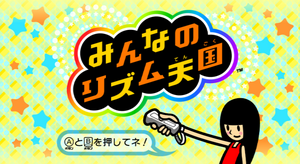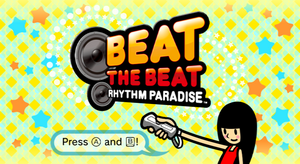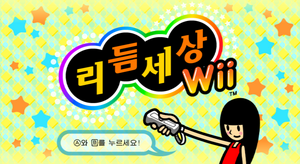Rhythm Heaven Fever/Development: Difference between revisions
mNo edit summary |
mNo edit summary |
||
| (5 intermediate revisions by the same user not shown) | |||
| Line 1: | Line 1: | ||
{{Development}}{{ | {{Development}}{{TCRF|Rhythm Heaven Fever|Rhythm Heaven Fever}} | ||
{| class="wikitable" align="center" style="width:100%; text-align:center" | {| class="wikitable" align="center" style="width:100%; text-align:center" | ||
!Title | !Title | ||
| Line 20: | Line 20: | ||
|} | |} | ||
==Development History== | ==Development History== | ||
For the new entry on the [[niwanetwork:Wii|Wii]], the team made use of its special features, such as being a home console allowing them to sneak in various details for on-lookers to find, which also led to the [[Two-Player Mode]]. The development team wondered what to do with the [[niwanetwork:Wii|Wii]] Remote controller. They considered | For the new entry on the [[niwanetwork:Wii|Wii]], the team made use of its special features, such as being a home console allowing them to sneak in various details for on-lookers to find, which also led to the [[Two-Player Mode]]. The development team wondered what to do with the [[niwanetwork:Wii|Wii]] Remote controller. They considered whether to stick with button controls or have motion controls, so they made a prototype trying out the latter. As this game would require a lot more swinging than other games, this would tire the player out, so they decided that just buttons would be perfectly fine. They also experimented with 3D models, but decided that 2D graphics lended themselves perfectly to the kind of snappy gameplay they were going for<ref>[https://iwataasks.nintendo.com/interviews/wii/rhythmheavenfever/0/0/ Iwata Asks - Rhythm Heaven Fever - Page 1]</ref>. | ||
Everyone on the development team pitched ideas for the game. The developers at [[niwanetwork:Nintendo|Nintendo]] could also design games however they wanted based on the music created by [[generasia:Tsunku|Tsunku♂]], which would often lead to him and his team being surprised at the visuals being completely different from what they had imagined. Despite the seeming mismatch of ideas, everything still came together. Everyone on the team got to name the [[Rhythm Games]] as well<ref>[https://iwataasks.nintendo.com/interviews/wii/rhythmheavenfever/0/1 Iwata Asks - Rhythm Heaven Fever - Page 2]</ref>. The development team was three times as large as the [[Rhythm Heaven|previous game]], with some team members who joined towards the end being fans of that game. There was a worry however that they would need to raise the difficulty for the benefit of players of the previous title, but they also wondered if it should be beginner-friendly. They asked various staff members of all age groups to try it out, and found that they had too much trouble, and adjusted the difficulty | Everyone on the development team pitched ideas for the game. The developers at [[niwanetwork:Nintendo|Nintendo]] could also design games however they wanted based on the music created by [[generasia:Tsunku|Tsunku♂]], which would often lead to him and his team being surprised at the visuals being completely different from what they had imagined. Despite the seeming mismatch of ideas, everything still came together. Everyone on the team got to name the [[Rhythm Games]] as well<ref>[https://iwataasks.nintendo.com/interviews/wii/rhythmheavenfever/0/1 Iwata Asks - Rhythm Heaven Fever - Page 2]</ref>. The development team was three times as large as the [[Rhythm Heaven|previous game]], with some team members who joined towards the end being fans of that game. There was a worry however that they would need to raise the difficulty for the benefit of players of the previous title, but they also wondered if it should be beginner-friendly. They asked various staff members of all age groups to try it out, and found that they had too much trouble, and adjusted the difficulty accordingly<ref>[https://iwataasks.nintendo.com/interviews/wii/rhythmheavenfever/0/3 Iwata Asks - Rhythm Heaven Fever - Page 4]</ref>. | ||
The earliest mention of the game to the public came in Nintendo's Investor Conference from January 28, 2011<ref>https://www.nintendo.co.jp/ir/events/110128/07.html</ref>, with no specific title for the game being mentioned other than {{Nihongo|『リズム天国』|"Rhythm Tengoku"}} along with early footage of [[Fork Lifter]], [[Samurai Slice (Wii)|Samurai Slice]] and [[Air Rally 2|Air Rally]]<ref>[https://www.youtube.com/watch?v=-n-ni11kEoo Rhythm Heaven Wii]</ref>. Later that year, a trailer was released alongside a demo being shown off at E3 2011<ref>[https://www.youtube.com/watch?v=EnKXX3KfiYs Rhythm Heaven Wii E3 Trailer (E3 2011)]</ref>, with the tentative titles of "Rhythm Heaven" in North America and "Rhythm Paradise" in Europe. Around this time on July 7, 2011, [[generasia:Tsunku|Tsunku♂]] shared on his official blog a family picture drawn by this game's staff to celebrate the birth of his third child<ref>"我が家に赤ちゃんが生まれたということで、ファミリーの絵を「みんなのリズム天国」の制作スタッフよりプレゼントしていただきました!" (The production staff of "Minna no Rhythm Tengoku" gave us a picture of the family as a baby was born!) ~ [https://ameblo.jp/tsunku-blog/entry-10946208716.html ファミリーの絵 | つんく♂オフィシャルブログ 「つんブロ♂芸能コース」Powered by Ameba] (Family Pictures | Tsunku♂ Official Blog " | The earliest mention of the game to the public came in Nintendo's Investor Conference from January 28, 2011<ref>https://www.nintendo.co.jp/ir/events/110128/07.html</ref>, with no specific title for the game being mentioned other than {{Nihongo|『リズム天国』|"Rhythm Tengoku"}} along with early footage of [[Fork Lifter]], [[Samurai Slice (Wii)|Samurai Slice]] and [[Air Rally 2|Air Rally]]<ref>[https://www.youtube.com/watch?v=-n-ni11kEoo Rhythm Heaven Wii]</ref>. Later that year, a trailer was released alongside a demo being shown off at E3 2011<ref>[https://www.youtube.com/watch?v=EnKXX3KfiYs Rhythm Heaven Wii E3 Trailer (E3 2011)]</ref>, with the tentative titles of "Rhythm Heaven" in North America and "Rhythm Paradise" in Europe. Around this time on July 7, 2011, [[generasia:Tsunku|Tsunku♂]] shared on his official blog a family picture drawn by this game's staff to celebrate the birth of his third child<ref>"我が家に赤ちゃんが生まれたということで、ファミリーの絵を「みんなのリズム天国」の制作スタッフよりプレゼントしていただきました!" (The production staff of "Minna no Rhythm Tengoku" gave us a picture of the family as a baby was born!) ~ [https://ameblo.jp/tsunku-blog/entry-10946208716.html ファミリーの絵 | つんく♂オフィシャルブログ 「つんブロ♂芸能コース」Powered by Ameba] (Family Pictures | Tsunku♂ Official Blog "Tsunblo♂ Entertainment Course" Powered by Ameba)</ref>. The game was finally released in Japan on July 21, 2011, with the title ''[[Minna no Rhythm Tengoku]]''. The meaning behind the title ("Everyone's Rhythm Heaven") is that everyone, be it those playing and those who stand by and watch, can enjoy it<ref>[https://iwataasks.nintendo.com/interviews/wii/rhythmheavenfever/0/5 Iwata Asks - Rhythm Heaven Fever - Page 6]</ref>. On August 12, 2011, [[wikipedia:Tsunku|Tsunku♂]] would post on his blog again announcing ''[[Minna no Rhythm Tengoku Zen Kyoku-shu]]'' (a soundtrack release for the game), which would release about two weeks later<ref>[https://ameblo.jp/tsunku-blog/entry-10983876527.html サウンドトラック | つんく♂オフィシャルブログ 「つんブロ♂芸能コース」Powered by Ameba] (Soundtrack | Tsunku♂ Official Blog "Tsunblo♂ Entertainment Course" Powered by Ameba)</ref>. On August 31, 2011, ''[[Minna no Rhythm Tengoku Zen Vocal-shu]]'' (a soundtrack release focusing on the vocal songs and their instrumentals) was released. | ||
In the localized versions of the game, the [[Endless Game]] [[Manzai]] was removed due to the Japanese-dialogue focused nature of the game and replaced with [[Mr. Upbeat]] (a remake of one from ''[[Rhythm Tengoku]]'')<ref>"Editor's note: The game Manzai is not available on versions outside of Japan due to the Japanese-dialogue focused nature of the game. It has been replaced with the game Mr. Upbeat for versions outside of Japan." ~ [https://iwataasks.nintendo.com/interviews/wii/rhythmheavenfever/0/3 Iwata Asks - Rhythm Heaven Fever - Page 4]</ref>. The game was released in North America, titled ''[[Rhythm Heaven Fever]]'', on February 13, 2012. On May 2, 2012, the European version of the game was announced<ref>[https://www.nintendo.co.uk/News/2012/Have-you-got-what-it-takes-to-Beat-the-Beat-253016.html Have you got what it takes to Beat the Beat? | 2012 | News | Nintendo]</ref> and released later on July 6 with the name ''[[Beat the Beat: Rhythm Paradise]]''. This version features a completely new translation of the in-game text in English, and also exclusively allows players to switch between English and Japanese voices (a feature that was [[Rhythm Heaven/Development|cut from the previous game]] due to memory constraints)<ref>[https://www.destructoid.com/gdc-09-chatting-with-nintendos-rich-amtower/ GDC 09: Chatting with Nintendo's Rich Amtower – Destructoid]</ref>, at the cost of not having any dubs in other languages<ref>[https://www.nintendo.co.uk/Games/Wii/Beat-the-Beat-Rhythm-Paradise-280605.html Beat the Beat: Rhythm Paradise | Wii | Games | Nintendo]</ref>. In September 2012, a small selection of the soundtrack was released overseas as ''[[Beat the Beat: Rhythm Paradise The Soundtrack]]''. On September 13, 2012, ''[[Beat the Beat: Rhythm Paradise]]'' would also be released in Australia. | In the localized versions of the game, the [[Endless Game]] [[Manzai]] was removed due to the Japanese-dialogue focused nature of the game and replaced with [[Mr. Upbeat]] (a remake of one from ''[[Rhythm Tengoku]]'')<ref>"Editor's note: The game Manzai is not available on versions outside of Japan due to the Japanese-dialogue focused nature of the game. It has been replaced with the game Mr. Upbeat for versions outside of Japan." ~ [https://iwataasks.nintendo.com/interviews/wii/rhythmheavenfever/0/3 Iwata Asks - Rhythm Heaven Fever - Page 4]</ref>. The game was released in North America, titled ''[[Rhythm Heaven Fever]]'', on February 13, 2012. On May 2, 2012, the European version of the game was announced<ref>[https://www.nintendo.co.uk/News/2012/Have-you-got-what-it-takes-to-Beat-the-Beat-253016.html Have you got what it takes to Beat the Beat? | 2012 | News | Nintendo]</ref> and released later on July 6 with the name ''[[Beat the Beat: Rhythm Paradise]]''. This version features a completely new translation of the in-game text in English, and also exclusively allows players to switch between English and Japanese voices (a feature that was [[Rhythm Heaven/Development|cut from the previous game]] due to memory constraints)<ref>[https://www.destructoid.com/gdc-09-chatting-with-nintendos-rich-amtower/ GDC 09: Chatting with Nintendo's Rich Amtower – Destructoid]</ref>, at the cost of not having any dubs in other languages<ref>[https://www.nintendo.co.uk/Games/Wii/Beat-the-Beat-Rhythm-Paradise-280605.html Beat the Beat: Rhythm Paradise | Wii | Games | Nintendo]</ref>. In September 2012, a small selection of the soundtrack was released overseas as ''[[Beat the Beat: Rhythm Paradise The Soundtrack]]''. On September 13, 2012, ''[[Beat the Beat: Rhythm Paradise]]'' would also be released in Australia. | ||
Not much is known about the localization process for the Korean version, though [[Endless Remix/Development|placeholder text]] suggests it was originally named {{Nihongo|"다함께 리듬세상"|Dahamkke Lideum Sesang|Rhythm World Together}}. The game was released in South Korea on September 12, 2013, with the title ''[[Rhythm World Wii]]''. This version uses a mix between English{{tt|*|Screwbot Factory, See-Saw, Air Rally, Catch of the Day, Launch Party, Bossa Nova, all vocal songs | Not much is known about the localization process for the Korean version, though [[Endless Remix/Development|placeholder text]] suggests it was originally named {{Nihongo|"다함께 리듬세상"|Dahamkke Lideum Sesang|Rhythm World Together}}. The game was released in South Korea on September 12, 2013, with the title ''[[Rhythm World Wii]]''. This version uses a mix between Japanese{{tt|*|Donk-Donk, Cheer Readers, Mochi Pounding}} and English{{tt|*|Screwbot Factory, See-Saw, Air Rally, Catch of the Day, Launch Party, Bossa Nova, all vocal songs}} voices, and new Korean{{tt|*|Board Meeting, Figure Fighter, Ringside, Packing Pests, Flipper-Flop, Exhibition Match, Love Rap, Tap Troupe, Shrimp Shuffle, Karate Man, Munchy Monk, Endless Remix, Clap Trap, Pirate Crew, Kung Fu Ball}} voices. | ||
The game would see a re-release in 2016 on the [[wikipedia:Wii U|Wii U]] on July 27 in Japan, November 10 in North America and November 24 in Europe. | The game would see a re-release in 2016 on the [[wikipedia:Wii U|Wii U]] on July 27 in Japan, November 10 in North America and November 24 in Europe. | ||
Latest revision as of 14:30, 22 November 2024

|

|
| Title | Minna no Rhythm Tengoku | Rhythm Heaven Fever | Beat the Beat: Rhythm Paradise | Rhythm World Wii |
|---|---|---|---|---|
| Region/Languages | Japan (Japanese) | United States of America (English) | Europe (UK English, French, German, Italian, Spanish) |
South Korea (Korean) |
| Release Date | July 21, 2011 | February 13, 2012 | July 6, 2012 | September 12, 2013 |
Development History
For the new entry on the Wii, the team made use of its special features, such as being a home console allowing them to sneak in various details for on-lookers to find, which also led to the Two-Player Mode. The development team wondered what to do with the Wii Remote controller. They considered whether to stick with button controls or have motion controls, so they made a prototype trying out the latter. As this game would require a lot more swinging than other games, this would tire the player out, so they decided that just buttons would be perfectly fine. They also experimented with 3D models, but decided that 2D graphics lended themselves perfectly to the kind of snappy gameplay they were going for[1].
Everyone on the development team pitched ideas for the game. The developers at Nintendo could also design games however they wanted based on the music created by Tsunku♂, which would often lead to him and his team being surprised at the visuals being completely different from what they had imagined. Despite the seeming mismatch of ideas, everything still came together. Everyone on the team got to name the Rhythm Games as well[2]. The development team was three times as large as the previous game, with some team members who joined towards the end being fans of that game. There was a worry however that they would need to raise the difficulty for the benefit of players of the previous title, but they also wondered if it should be beginner-friendly. They asked various staff members of all age groups to try it out, and found that they had too much trouble, and adjusted the difficulty accordingly[3].
The earliest mention of the game to the public came in Nintendo's Investor Conference from January 28, 2011[4], with no specific title for the game being mentioned other than 『リズム天国』 ("Rhythm Tengoku"?) along with early footage of Fork Lifter, Samurai Slice and Air Rally[5]. Later that year, a trailer was released alongside a demo being shown off at E3 2011[6], with the tentative titles of "Rhythm Heaven" in North America and "Rhythm Paradise" in Europe. Around this time on July 7, 2011, Tsunku♂ shared on his official blog a family picture drawn by this game's staff to celebrate the birth of his third child[7]. The game was finally released in Japan on July 21, 2011, with the title Minna no Rhythm Tengoku. The meaning behind the title ("Everyone's Rhythm Heaven") is that everyone, be it those playing and those who stand by and watch, can enjoy it[8]. On August 12, 2011, Tsunku♂ would post on his blog again announcing Minna no Rhythm Tengoku Zen Kyoku-shu (a soundtrack release for the game), which would release about two weeks later[9]. On August 31, 2011, Minna no Rhythm Tengoku Zen Vocal-shu (a soundtrack release focusing on the vocal songs and their instrumentals) was released.
In the localized versions of the game, the Endless Game Manzai was removed due to the Japanese-dialogue focused nature of the game and replaced with Mr. Upbeat (a remake of one from Rhythm Tengoku)[10]. The game was released in North America, titled Rhythm Heaven Fever, on February 13, 2012. On May 2, 2012, the European version of the game was announced[11] and released later on July 6 with the name Beat the Beat: Rhythm Paradise. This version features a completely new translation of the in-game text in English, and also exclusively allows players to switch between English and Japanese voices (a feature that was cut from the previous game due to memory constraints)[12], at the cost of not having any dubs in other languages[13]. In September 2012, a small selection of the soundtrack was released overseas as Beat the Beat: Rhythm Paradise The Soundtrack. On September 13, 2012, Beat the Beat: Rhythm Paradise would also be released in Australia.
Not much is known about the localization process for the Korean version, though placeholder text suggests it was originally named "다함께 리듬세상" (Dahamkke Lideum Sesang?, Rhythm World Together). The game was released in South Korea on September 12, 2013, with the title Rhythm World Wii. This version uses a mix between Japanese* and English* voices, and new Korean* voices.
The game would see a re-release in 2016 on the Wii U on July 27 in Japan, November 10 in North America and November 24 in Europe.
References
- ↑ Iwata Asks - Rhythm Heaven Fever - Page 1
- ↑ Iwata Asks - Rhythm Heaven Fever - Page 2
- ↑ Iwata Asks - Rhythm Heaven Fever - Page 4
- ↑ https://www.nintendo.co.jp/ir/events/110128/07.html
- ↑ Rhythm Heaven Wii
- ↑ Rhythm Heaven Wii E3 Trailer (E3 2011)
- ↑ "我が家に赤ちゃんが生まれたということで、ファミリーの絵を「みんなのリズム天国」の制作スタッフよりプレゼントしていただきました!" (The production staff of "Minna no Rhythm Tengoku" gave us a picture of the family as a baby was born!) ~ ファミリーの絵 | つんく♂オフィシャルブログ 「つんブロ♂芸能コース」Powered by Ameba (Family Pictures | Tsunku♂ Official Blog "Tsunblo♂ Entertainment Course" Powered by Ameba)
- ↑ Iwata Asks - Rhythm Heaven Fever - Page 6
- ↑ サウンドトラック | つんく♂オフィシャルブログ 「つんブロ♂芸能コース」Powered by Ameba (Soundtrack | Tsunku♂ Official Blog "Tsunblo♂ Entertainment Course" Powered by Ameba)
- ↑ "Editor's note: The game Manzai is not available on versions outside of Japan due to the Japanese-dialogue focused nature of the game. It has been replaced with the game Mr. Upbeat for versions outside of Japan." ~ Iwata Asks - Rhythm Heaven Fever - Page 4
- ↑ Have you got what it takes to Beat the Beat? | 2012 | News | Nintendo
- ↑ GDC 09: Chatting with Nintendo's Rich Amtower – Destructoid
- ↑ Beat the Beat: Rhythm Paradise | Wii | Games | Nintendo
| Rhythm Heaven Fever | ||
|---|---|---|
| Medal Corner | ||
| Rhythm Games | ||
| Two-Player Menu | ||
| Endless Games One Player |
||
| Endless Games Two Player |
||
| Rhythm Toys | ||
| Extra Games | ||
| Miscellaneous | Music Corner • Reading Material • Rhythm Test • Perfect Campaign • Characters • The Rhythm League • Rhythm Heaven • Live House OGU • Development History • Seika Relay | |

























